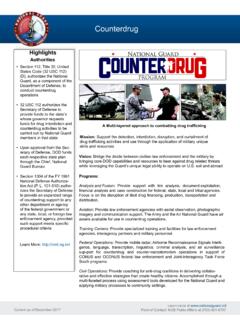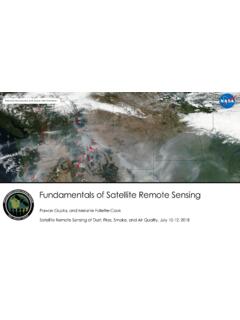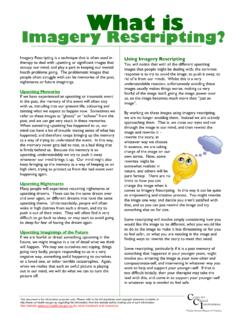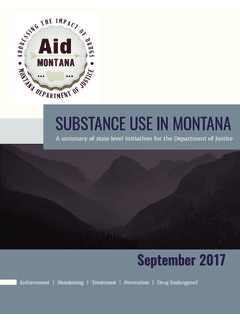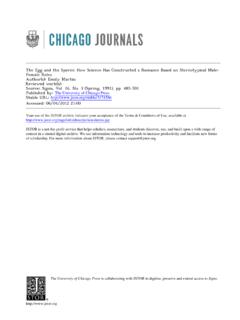Transcription of You Only Look Twice: Rapid Multi-Scale Object ... - arXiv
1 You Only Look Twice: Rapid Multi-Scale Object Detection In Satellite imagery Adam Van Etten CosmiQ Works, In-Q-Tel ABSTRACT The application of deep learning methods to traditional Object Detection of small objects in large swaths of imagery is one of detection pipelines is non-trivial for a variety of reasons. The unique the primary problems in satellite imagery analytics. While Object aspects of satellite imagery necessitate algorithmic contributions to [ ] 24 May 2018. detection in ground-based imagery has benefited from research address challenges related to the spatial extent of foreground target into new deep learning approaches, transitioning such technology objects, complete rotation invariance, and a large scale search space.
2 To overhead imagery is nontrivial. Among the challenges is the Excluding implementation details, algorithms must adjust for: sheer number of pixels and geographic extent per image: a single Small spatial extent In satellite imagery objects of interest DigitalGlobe satellite image encompasses > 64 km2 and over 250. are often very small and densely clustered, rather than million pixels. Another challenge is that objects of interest are the large and prominent subjects typical in ImageNet data. minuscule (often only 10 pixels in extent), which complicates In the satellite domain, resolution is typically defined as traditional computer vision techniques.
3 To address these issues, we the ground sample distance (GSD), which describes the propose a pipeline (You Only Look Twice, or YOLT) that evaluates physical size of one image pixel. Commercially available satellite images of arbitrary size at a rate of km2 /s. The imagery varies from 30 cm GSD for the sharpest Digital- proposed approach can rapidly detect objects of vastly different Globe imagery , to 3 4 meter GSD for Planet imagery . This scales with relatively little training data over multiple sensors. We means that for small objects such as cars each Object will evaluate large test images at native resolution, and yield scores of be only 15 pixels in extent even at the highest resolution.
4 F 1 > for vehicle localization. We further explore resolution and Complete rotation invariance Objects viewed from over- Object size requirements by systematically testing the pipeline at head can have any orientation ( ships can have any decreasing resolution, and conclude that objects only 5 pixels in heading between 0 and 360 degrees, whereas trees in Ima- size can still be localized with high confidence. Code is available at geNet data are reliably vertical). Training example frequency There is a relative dearth of training data (though efforts such as SpaceNet1 are attempt- KEYWORDS ing to ameliorate this issue). Computer Vision, Satellite imagery , Object Detection Ultra high resolution Input images are enormous (often hundreds of megapixels), so simply downsampling to the input size required by most algorithms (a few hundred pixels) is not an option (see Figure 1).
5 1 INTRODUCTION. Computer vision techniques have made great strides in the past few The contribution in this work specifically addresses each of these years since the introduction of convolutional neural networks [5] issues separately, while leveraging the relatively constant distance in the ImageNet [13] competition. The availability of large, high- from sensor to Object , which is well known and is typically 400. quality labelled datasets such as ImageNet [13], PASCAL VOC [2] km. This coupled with the nadir facing sensor results in consistent and MS COCO [6] have helped spur a number of impressive ad- pixel size of objects.
6 Vances in Rapid Object detection that run in near real-time; three of Section 2 details in further depth the challenges faced by standard the best are: Faster R-CNN [12], SSD [7], and YOLO [10] [11]. Faster algorithms when applied to satellite imagery . The remainder of R-CNN typically ingests 1000 600 pixel images, whereas SSD uses this work is broken up to describe the proposed contributions as 300 300 or 512 512 pixel input images, and YOLO runs on either follows. To address small, dense clusters, Section describes 416 416 or 544 544 pixel inputs. While the performance of all a new, finer-grained network architecture. Sections and these frameworks is impressive, none can come remotely close to in- detail our method for splitting, evaluating, and recombining large gesting the 16, 000 16, 000 input sizes typical of satellite imagery .
7 Test images of arbitrary size at native resolution. With regard to Of these three frameworks, YOLO has demonstrated the greatest rotation invariance and small labelled training dataset sizes, Section inference speed and highest score on the PASCAL VOC dataset. The 4 describes data augmentation and size requirements. Finally, the authors also showed that this framework is highly transferrable performance of the algorithm is discussed in detail in Section 6. to new domains by demonstrating superior performance to other frameworks ( , SSD and Faster R-CNN) on the Picasso Dataset [3] and the People-Art Dataset [1]. Due to the speed, accuracy, and flexibility of YOLO, we accordingly leverage this system as the inspiration for our satellite imagery Object detection framework.
8 1 Figure 2: Challenges of the standard Object detection net- work architecture when applied to overhead vehicle detec- tion. Each image uses the same standard YOLO architecture model trained on 416 416 pixel cutouts of cars from the COWC dataset. Left: Model applied to a large 4000 4000. pixel test image downsampled to a size of 416 416; none of Figure 1: DigitalGlobe 8 8 km ( 16, 000 16, 000 pixels) the 1142 cars in this image are detected. Right: Model ap- image at 50 cm GSD near the Panama Canal. One 416 416 plied to a small 416 416 pixel cutout; the excessive false pixel sliding window cutout is shown in red. For an image negative rate is due to the high density of cars that cannot this size, there are 1500 unique cutouts.
9 Be differentiated by the 13 13 grid. 2 RELATED WORK We also note that the large sizes satellite images preclude simple Deep learning approaches have proven effective for ground-based approaches to some of the problems noted above. For example, Object detection, though current techniques are often still subopti- upsampling the image to ensure that objects of interest are large mal for overhead imagery applications. For example, small objects and dispersed enough for standard architectures is infeasible, since in groups, such as flocks of birds present a challenge [10], caused this approach would also increase runtime many-fold.
10 Similarly, in part by the multiple downsampling layers of all three convolu- running a sliding window classifier across the image to search for tional network approaches listed above (YOLO, SDD, Faster-RCNN). objects of interest quickly becomes computationally intractable, Further, these multiple downsampling layers result in relatively since multiple window sizes will be required for each Object size. course features for Object differentiation; this poses a problem if For perspective, one must evaluate over one million sliding window objects of interest are only a few pixels in extent. For example, cutouts if the target is a 10 meter boat in a DigitalGlobe image.
![arXiv:0706.3639v1 [cs.AI] 25 Jun 2007](/cache/preview/4/1/3/9/3/1/4/b/thumb-4139314b93ef86b7b4c2d05ebcc88e46.jpg)

![arXiv:1301.3781v3 [cs.CL] 7 Sep 2013](/cache/preview/4/d/5/0/4/3/4/0/thumb-4d504340120163c0bdf3f4678d8d217f.jpg)
![@google.com arXiv:1609.03499v2 [cs.SD] 19 Sep 2016](/cache/preview/c/3/4/9/4/6/9/b/thumb-c349469b499107d21e221f2ac908f8b2.jpg)






